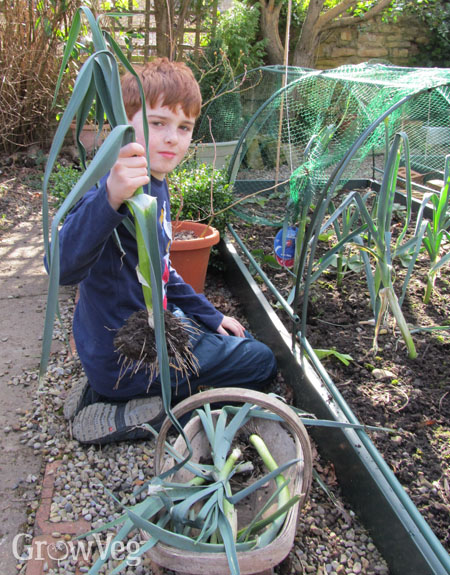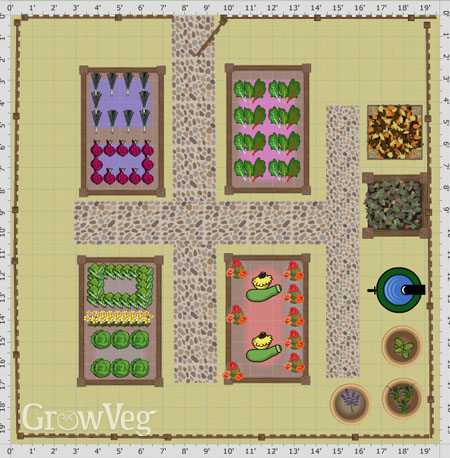How To Plant Your First Garden
Plan Your First Vegetable Garden in 5 Easy Steps

Taking control of your own food supply by growing vegetables is a smart move if you want to become more self-reliant. But if you've never grown food before it can be daunting. There's so much to learn and so many things that could potentially go wrong! When you're full of enthusiasm it's tempting to surge ahead and get seeds or plants in the ground straight away, but planning is the key to good harvests.
So let's not waste time. Here are five things you need to do – before you plant a single thing – to give your new vegetable garden the best chance of success.
Step 1: Find Your Garden's Vegetable-Growing Sweet Spot
Make time to prowl round your garden just observing. Ideally you'd spent a whole year observing your garden, but this is the real world and if you can do that you're a much more patient gardener than me!
Identify which areas get the most sun and which are shadier. Most crops, and particularly tender crops like tomatoes, prefer plenty of sun and warmth, so in all but the hottest regions it's usually best to grow vegetables in your sunniest spot. That's not to say that shadier areas are completely out of bounds – there are crops that will grow in partial shade too, for instance lettuce and other leafy greens. Remember that the amount of sun and shade your garden receives will change as the year progresses.

The perfect spot for your vegetable garden has some through-flow of air, which helps keep plants healthy, but is not a wide open plain or in the path of a wind tunnel. Add windbreaks if you need to. Hedges make excellent windbreaks because they allow air to pass through while reducing the power of the wind.
Step 2: Get Down and Dirty With Your Soil
Now look down at your feet. Does water pool on the surface after rain, or does the soil become parched and cracked when the weather hots up? If you're unsure, dig a pit to the depth of a spade's blade and fill it with water. Watch how quickly it drains away. Fast-draining soils will need regular watering and require more fertilizer. If your pit takes hours to drain it may be a wise move to install raised beds or look for a better-draining spot elsewhere.
Soil can be improved but it's near-impossible to change it completely, so aim to work with your soil's strengths and try to improve its weaknesses. Adding organic matter such as compost will improve any soil type.

Step 3: Plan Your Garden Beds
Assuming you're gardening by hand and not with a tractor, it's usually easier to grow in beds narrow enough that you can reach into the centre from both sides without having to step on the soil. Compacting the soil by standing on it makes it harder for plant roots to penetrate and seek out air, water and nutrients. The length of your beds is up to you, but if they're too long to walk around quickly you'll soon find yourself taking shortcuts across the soil. Raised beds are often recommended to the beginning gardener, but they are entirely optional.
One of the most important yet commonly forgotten elements of a vegetable garden is good pathways. Paths can be made of hard materials such as slabs or gravel, surfaced with woodchip, sawdust or other bulky organic material (which need occasional topping up), or just grass. Make sure paths are wide enough to enable you to reach all beds with a wheelbarrow on at least one side.

Step 4: Choose Vegetables That Will Succeed
Growing half a dozen different types of vegetables is a good start – enough to be interesting and to help you learn a lot, but not so many that you're likely to become completely overwhelmed. Even success can be a challenge – just ask anyone who's ever grown more than a couple of zucchini plants! You'll be astounded by the skills and knowledge you'll gain during the course of your first growing season. So start with fail-safe crops and next year use what you've learned to add a few more crops to your garden.
The 'Easy to grow' option in our Garden Planner's Custom Filter tool can help you to narrow down the choice of what to grow. You can also filter by crop family, which makes it easy to work out what to grow together. Growing plants from the same family together makes maintenance, crop rotation and using pest barriers such as netting easier.
Step 5: Dig It – or Don't
At the heart of every successful vegetable garden is good soil. The traditional way to prepare soil is to weed thoroughly and dig it over, incorporating compost or manure as you go. Personally, I've given up on this method. It spreads weed seeds and bits of root from perennial weeds, and is time-consuming and hard on the back.

It's far simpler to lay cardboard or thick layers of newspaper to keep the weeds well below the surface. Water it then cover with a 15cm (6in) thick layer of compost and/or well-rotted manure. Cut holes to plant through, and keep an eye out for weeds sneaking out through the holes. Seeds of all but deep-rooting crops like parsnips can go straight into the growing medium without making holes. You can use boards around the edges to create a raised bed, but it's not essential.
This technique is known as no-dig or no-till, and it does what it says on the tin. You never dig up the soil, apart from when harvesting root crops or when planting potatoes (and sometimes not even then!). Instead you add a fresh layer of organic matter on top of the soil at least once a year, and let worms and other soil organisms do the digging for you. This is faster and easier than turning the soil annually, and avoids disturbing the delicate web of life beneath the soil surface that helps keep your garden healthy.
Use our Garden Planner to plan how your garden is going to look and change over time, and record your progress with notes and photos in the included Garden Journal . Arm yourself with a hoe and some seed packets – and go grow!
< All Guides
How To Plant Your First Garden
Source: https://www.growveg.com/guides/plan-your-first-vegetable-garden-in-5-easy-steps/
Posted by: smiththared1978.blogspot.com

0 Response to "How To Plant Your First Garden"
Post a Comment